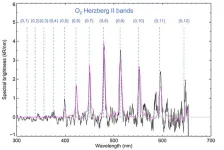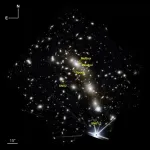(Press-News.org) An international team led by scientists from the University of Liège has observed, for the first time in the visible range, a glow on the night side of the planet Mars. These new observations provide a better understanding of the dynamics of the upper atmosphere of the Red Planet and its variations throughout the year.
A scientific team led by researchers from the Laboratory for Planetary and Atmospheric Physics (LPAP) at the University of Liège (BE) has just observed, for the first time, lights in the night sky over Mars using the UVIS-NOMAD instrument on board the Trace Gas Orbiter (TGO) satellite of the European Space Agency (ESA). This instrument is part of the NOMAD spectrometer suite developed at the Royal Institute for Space Aeronomy in Uccle, and tested and calibrated at the Liège Space Centre. It was inserted into circular Martian orbit at an altitude of 400 km in 2008.
Initially designed to map the ozone layer surrounding the planet in the ultraviolet, UVIS-NOMAD covers a spectral range extending from the near ultraviolet to red. For this purpose, the instrument is usually oriented towards the centre of the planet and observes sunlight reflected by the planetary surface and atmosphere. Based on a proposal from our laboratory, the instrument was oriented towards the limb of the planet in order to observe its atmosphere from the edge," explains Jean-Claude Gérard, planetologist at ULiège. Back in 2020, we were already able to detect the presence of a green emission between 40 and 150 km in altitude, present during the Martian day. This was due to the dissociation of the CO2 molecule, the main constituent of the atmosphere, by ultraviolet solar radiation".
A long journey for oxygen atoms
The TGO satellite, when observing the atmosphere at night, has just detected a new emission between 40 and 70 km altitude. This emission is due to the recombination of oxygen atoms created in the summer atmosphere and carried by the winds towards the high winter latitudes," explains Lauriane Soret, a researcher at LPAP. There, the atoms recombine on contact with CO2 to reform an O2 molecule in an excited state that relaxes and emits light in the visible range". This light emission is concentrated in the polar regions to the north and south, where the oxygen atoms converge in the downward branch of the gigantic trajectory from the opposite hemisphere. The intensity of the emission is high, in the visible range. This process seems to be reversed every half Martian year*, and the luminosity then changes hemisphere. A similar emission was analysed on Venus by the same team using images from the Venus Express satellite. On Venus, the atoms travel from the sunlit side to the dark side where they emit the same glow as on Mars.
ULiège researchers at the forefront
LPAP researchers played a key role in these observations. After highlighting the presence of a layer of green light surrounding the planet on the day side, they identified the night-time emission. The study will be continued during the TGO mission and will provide us with valuable information about the dynamics of the Martian upper atmosphere and its variations over the course of the Martian year," continues Lauriane Soret. We have noticed that another ultraviolet emission due to the nitric oxide (NO) molecule is also observed by UVIS in the same regions. Comparing the two emissions will enable us to refine the diagnosis and identify the processes involved.
The NO molecule also emits light when oxygen and nitrogen atoms recombine. As with the radiation from the O2 molecule, the atoms are formed in sunlight, transported by the winds to the other hemisphere and recombine during the downward motion in the polar regions.
These new observations are unexpected and interesting for future journeys to the Red Planet," enthuses Jean-Claude Gérard. The intensity of the night glow in the polar regions is such that simple and relatively inexpensive instruments in Martian orbit could map and monitor atmospheric flows. A future ESA mission could carry a camera for global imaging. In addition, the emission is sufficiently intense to be observable during the polar night by future astronauts in orbit or from the Martian ground'.
Benoit Hubert, researcher at LPAP, concludes: "Remote sensing of these emissions is an excellent tool for probing the composition and dynamics of Mars' upper atmosphere between 40 and 80 km. This region is inaccessible to direct methods of measuring composition using satellites''.
(* A Martian year lasts 687 Earth days.)
END
Glow in the visible range detected for the first time in the Martian night
A study by researchers at the University of Liège, using the UVIS-NOMAD instrument, has detected visible emission in the upper atmosphere of Mars
2023-11-09
ELSE PRESS RELEASES FROM THIS DATE:
UChicago's Pritzker School of Molecular Engineering advances lithium-metal batteries, paving the way for safer, more powerful devices
2023-11-09
The boom in phones, laptops and other personal devices over the last few decades has been made possible by the lithium-ion (Li-ion) battery, but as climate change demands more powerful batteries for electric vehicles and grid-scale renewable storage, lithium-ion technology might not be enough.
Lithium-metal batteries (LMBs) have theoretical capacities an order of magnitude greater than lithium-ion, but a more literal boom has stymied research for decades.
“A compounding challenge that further doomed the first wave of LMB commercialization in the late 1980s was their propensity to ...
Sylvester research shows how interactions between tumor genes and microenvironment influence treatment response in multiple myeloma
2023-11-09
MIAMI, FLORIDA (EMBARGOED UNTIL NOV. 9, 2023, AT 11 A.M. ET) – A multicenter study led by researchers at Sylvester Comprehensive Cancer Center at the University of Miami Miller School of Medicine shows how interactions between tumor cells and immune components of the microenvironment can impact treatment responses and outcomes in patients newly diagnosed with multiple myeloma who undergo combination treatments that include targeted immunotherapy.
New drugs developed over the past two decades have dramatically improved survival rates, with “deep” and sustained treatment ...
Scientists caution against a reliance on mechanical devices to clear water bodies of plastic
2023-11-09
An international group of scientists has cautioned against reliance on mechanical cleanup devices as a means of addressing the plastic pollution crisis.
The researchers – comprising a number of the world’s foremost experts in plastic pollution – say they appreciate the clear and pressing need to tackle the millions of tonnes of waste that have already accumulated in the ocean and waterways.
However, they caution that plastic removal technologies used so far have shown varied efficiency in the amount of waste material they are able to collect, many have not been tested at all.
In fact, some have been shown to harm quantities of marine organisms – including ...
UTSA’s Jessica Eise wins funding to advance climate science advocacy research
2023-11-09
(San Antonio, November 9, 2023) — The National Science Foundation (NSF) has awarded Jessica Eise, an assistant professor of social and environmental challenges in the University of Texas at San Antonio Department of Communication, $425,000 for her project to explore how to create enduring change in environmental public behavior to support actions that will effectively address climate change and its impacts on society.
Despite four decades of climate change communication, the world has yet to see adequate public action and policymaker support to substantively address the challenge. Eise’s findings will empower ...
Women produce skin temperature data that are just as predictable as men
2023-11-09
Women produce physiological data that is just as predictable as men, at least when it comes to skin temperature. This might seem like common sense, but variations in body signals due to menstrual cycles, such as temperature, were used as an excuse to keep women out of clinical studies for decades.
The data for the finding was gathered from a wearable device to continuously monitor the skin temperature of 600 people, half female and half male, over six months.
The team found that there were more differences between any ...
Vanderbilt and Duke awarded Moore Foundation grant to improve oversight of AI technology in health care systems
2023-11-09
Vanderbilt University Medical Center (VUMC) and Duke University School of Medicine have been awarded a $1.25 million grant from the Gordon and Betty Moore Foundation for the project “Measuring Artificial Intelligence (AI) Maturity in Healthcare Organizations.”
Working with the Coalition for Health AI (CHAI) and the University of Iowa, a team of experts will leverage the grant to develop a maturity model framework. The project leads are Peter Embí, MD, MS, and Laurie Novak, ...
Doctoral degrees without borders
2023-11-09
Doctoral students at nine New York City area graduate engineering programs will soon be able to take courses at each other’s institutions without any additional tuition, as part of a new multi-school agreement announced today.
The Inter-University Engineering Doctoral Consortium (IUEDC), led by NYU Tandon School of Engineering, encourages Ph.D. students to complement their primary program by taking courses of interest offered at different schools, providing access to specialty instruction and expertise that may not be available at their home universities. Students should be ...
Scientists find 14 new transient objects in space by peering through the 'Christmas Tree Galaxy Cluster'
2023-11-09
An international team of scientists, led by University of Missouri’s Haojing Yan, used NASA’s James Webb Space Telescope (JWST) to discover 14 new transient objects during their time-lapse study of galaxy cluster MACS0416 — located about 4.3 billion light years from Earth — which they’ve dubbed as the “Christmas Tree Galaxy Cluster.”
“Transients are objects in space, like individual stars, that appear to suddenly brighten by orders of magnitudes and then fade away,” said Yan, an associate professor in the Department ...
2023 AAAS Kavli Science Journalism Award winners named
2023-11-09
Stories about troubling aspects of science’s past as well as some hopeful signs for its future are among the winners of the 2023 AAAS Kavli Science Journalism Awards.
Presenter Adam Rutherford and producer Ilan Goodman won a Gold Award in the Audio category for a BBC series on the eugenics movement and its continuing repercussions in the modern age. Ashley Smart of Undark magazine won the Gold Award in the Science Reporting In-Depth category for a piece on the lingering impact of scientific racism, including the appropriation of legitimate genetics research for extremist ends.
On a more ...
Regenstrief experts will address national, global challenges at AMIA symposium
2023-11-09
INDIANAPOLIS -- Regenstrief Institute informaticians and other data experts will share their research insights and innovations from November 11-15 at the 2023 American Medical Informatics Association (AMIA) Annual Symposium in New Orleans, Louisiana.
Two Regenstrief researchers also were part of the leadership team that organized and helped set the agenda for the conference, “Transforming Healthcare and Biomedicine for a Sustainable Future.”
AMIA’s Annual Symposium is the premier medical informatics event, presenting leading-edge scientific research and a wide array of scientific sessions. The symposium presents work from across the spectrum of the informatics ...
LAST 30 PRESS RELEASES:
Tracing the quick synthesis of an industrially important catalyst
New software sheds light on cancer’s hidden genetic networks
UT Health San Antonio awarded $3 million in CPRIT grants to bolster cancer research and prevention efforts in South Texas
Third symposium spotlights global challenge of new contaminants in China’s fight against pollution
From straw to soil harmony: International team reveals how biochar supercharges carbon-smart farming
Myeloma: How AI is redrawing the map of cancer care
Manhattan E. Charurat, Ph.D., MHS invested as the Homer and Martha Gudelsky Distinguished Professor in Medicine at the University of Maryland School of Medicine
Insilico Medicine’s Pharma.AI Q4 Winter Launch Recap: Revolutionizing drug discovery with cutting-edge AI innovations, accelerating the path to pharmaceutical superintelligence
Nanoplastics have diet-dependent impacts on digestive system health
Brain neuron death occurs throughout life and increases with age, a natural human protein drug may halt neuron death in Alzheimer’s disease
SPIE and CLP announce the recipients of the 2025 Advanced Photonics Young Innovator Award
Lessons from the Caldor Fire’s Christmas Valley ‘Miracle’
Ant societies rose by trading individual protection for collective power
Research reveals how ancient viral DNA shapes early embryonic development
A molecular gatekeeper that controls protein synthesis
New ‘cloaking device’ concept to shield sensitive tech from magnetic fields
Researchers show impact of mountain building and climate change on alpine biodiversity
Study models the transition from Neanderthals to modern humans in Europe
University of Phoenix College of Doctoral Studies releases white paper on AI-driven skilling to reduce burnout and restore worker autonomy
AIs fail at the game of visual “telephone”
The levers for a sustainable food system
Potential changes in US homelessness by ending federal support for housing first programs
Vulnerability of large language models to prompt injection when providing medical advice
Researchers develop new system for high-energy-density, long-life, multi-electron transfer bromine-based flow batteries
Ending federal support for housing first programs could increase U.S. homelessness by 5% in one year, new JAMA study finds
New research uncovers molecular ‘safety switch’ shielding cancers from immune attack
Bacteria resisting viral infection can still sink carbon to ocean floor
Younger biological age may increase depression risk in older women during COVID-19
Bharat Innovates 2026 National Basecamp Showcases India’s Most Promising Deep-Tech Ventures
Here’s what determines whether your income level rises or falls
[Press-News.org] Glow in the visible range detected for the first time in the Martian nightA study by researchers at the University of Liège, using the UVIS-NOMAD instrument, has detected visible emission in the upper atmosphere of Mars







